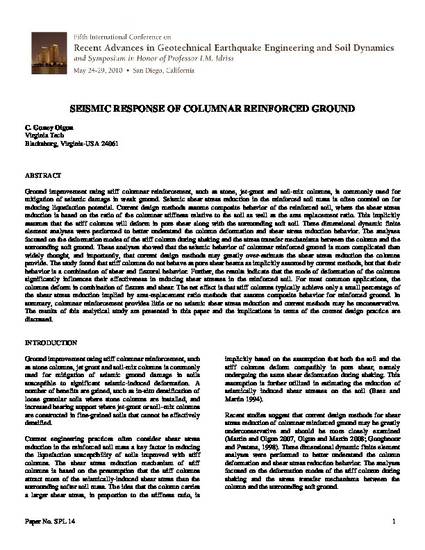
Ground improvement using stiff columnar reinforcement, such as stone, jet-grout and soil-mix columns, is commonly used for mitigation of seismic damage in weak ground. Seismic shear stress reduction in the reinforced soil mass is often counted on for reducing liquefaction potential. Current design methods assume composite behavior of the reinforced soil, where the shear stress reduction is based on the ratio of the columnar stiffness relative to the soil as well as the area replacement ratio. This implicitly assumes that the stiff columns will deform in pure shear along with the surrounding soft soil. Three dimensional dynamic finite element analyses were performed to better understand the column deformation and shear stress reduction behavior. The analyses focused on the deformation modes of the stiff column during shaking and the stress transfer mechanisms between the column and the surrounding soft ground. These analyses showed that the seismic behavior of columnar reinforced ground is more complicated than widely thought, and importantly, that current design methods may greatly over-estimate the shear stress reduction the columns provide. The study found that stiff columns do not behave as pure shear beams as implicitly assumed by current methods, but that their behavior is a combination of shear and flexural behavior. Further, the results indicate that the mode of deformation of the columns significantly influences their effectiveness in reducing shear stresses in the reinforced soil. For most common applications, the columns deform in combination of flexure and shear. The net effect is that stiff columns typically achieve only a small percentage of the shear stress reduction implied by area-replacement ratio methods that assume composite behavior for reinforced ground. In summary, columnar reinforcement provides little or no seismic shear stress reduction and current methods may be unconservative. The results of this analytical study are presented in this paper and the implications in terms of the current design practice are discussed.
© 2010 Missouri University of Science and Technology, All rights reserved.
Available at: http://works.bepress.com/c-olgun/69/
